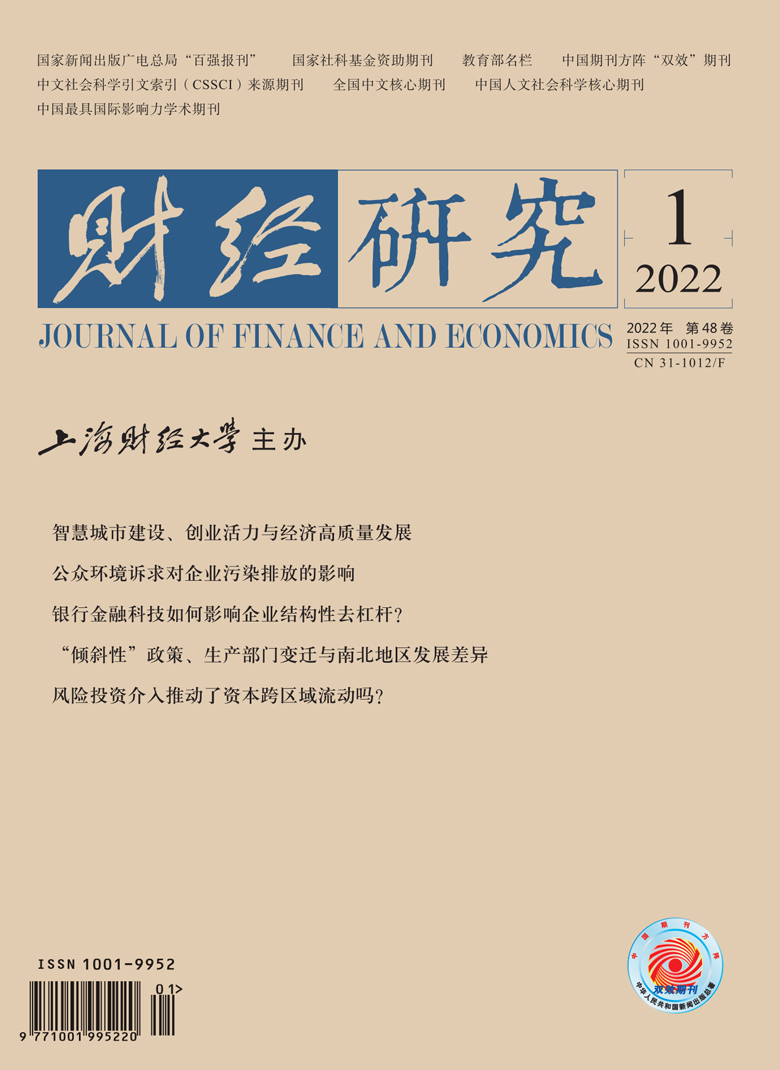“倾斜性”政策对各区域形成优势互补、共同发展的新格局发挥了重要作用。借助于这些区域政策,地方政府会更积极地介入经济活动,其对生产部门结构变迁的冲击具有时空异质性,这为讨论南北发展分化提供了一种新的线索。因此,文章构建了“倾斜性”政策、两部门结构与区域发展的均衡模型,采用机器学习方法对2003—2018年277座城市高维特征分阶段开展实证分析,并使用因果森林估计了“倾斜性”政策的异质性处理效果,经由省份聚类解决算法的“过拟合”问题以及用岭回归和社会网络分析等进行了稳健性检验。结果发现:(1)旨在协调区域平衡发展的政策在南方地区的效果优于北方,尤其在2012年以后,效果更明显。(2)“倾斜性”政策会提高欠发达地区不可贸易部门的份额,引致长期生产率提升速度比可贸易部门更缓慢,尽管这种现象在我国普遍存在,但北方城市相对更严重,这是南北区域发展差距扩大的重要原因。因此,考虑到传统区域政策的异质性和不可持续特征,未来区域政策的重心应侧重于如何提升欠发达地区人力资本积累以及企业的贸易参与度。
“倾斜性”政策、生产部门变迁与南北地区发展差异——来自机器学习的因果推断
摘要
参考文献
7 陆铭,李鹏飞,钟辉勇. 发展与平衡的新时代−新中国70年的空间政治经济学[J]. 管理世界,2019,(10):11−23. DOI:10.3969/j.issn.1002-5502.2019.10.003
16 Athey S, Imbens G. Recursive partitioning for heterogeneous causal effects[J]. Proceedings of the National Academy of Sciences of the United States of America,2016,113(27): 7353−7360. DOI:10.1073/pnas.1510489113
17 Dix-Carneiro R, Kovak B K. Margins of labor market adjustment to trade[J]. Journal of International Economics,2019,117: 125−142. DOI:10.1016/j.jinteco.2019.01.005
18 Fagiolo G. The international-trade network: Gravity equations and topological properties[J]. Journal of Economic Interaction and Coordination,2010,5(1): 1−25. DOI:10.1007/s11403-010-0061-y
19 Gollin D, Jedwab R, Vollrath D. Urbanization with and without industrialization[J]. Journal of Economic Growth,2016,21(1): 35−70. DOI:10.1007/s10887-015-9121-4
20 Knittel C R, Stolper S. Using machine learning to target treatment: The case of household energy use[R]. NBER Working Paper No.26531, 2019.
21 Kolaczy E D, Csárdi G. Statistical analysis of network data with R[M]. New York: Springer, 2014.
22 Samuelson P A. Theoretical notes on trade problems[J]. The Review of Economics and Statistics,1964,46(2): 145−154. DOI:10.2307/1928178
23 Sen A, Smith T E. Gravity models of spatial interaction behavior[M]. Berlin, Heidelberg: Springer, 1995.
24 Taylor P J, Hoyler M, Verbruggen R. External urban relational process: Introducing central flow theory to complement central place theory[J]. Urban Studies,2010,47(13): 2803−2818. DOI:10.1177/0042098010377367
引用本文
胡尊国, 顾金鑫, 陈颖. “倾斜性”政策、生产部门变迁与南北地区发展差异——来自机器学习的因果推断[J]. 财经研究, 2022, 48(1): 93-107.
导出参考文献,格式为:





 5957
5957  5164
5164

